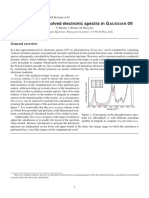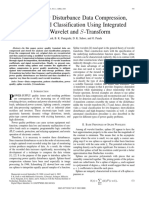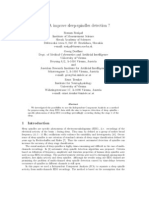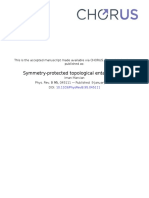Bi Spectrum For EEG Analysis
Uploaded by
Arun Kumar ABi Spectrum For EEG Analysis
Uploaded by
Arun Kumar AAN INTRODUCTION TO THE BISPECTRUM FOR EEG ANALYSIS
D. Wong, D.A. Clifton, L. Tarassenko
Biomedical Signal Processing Group, Institute of Biomedical Engineering, University of Oxford, Oxford, UK
wong@robots.ox.ac.uk
Abstract - This paper provides a tutorial for bispectral
analysis, a signal processing technique commonly used is the triple product. Using the convolution
for the analysis of the Electroencephalogram (EEG). theorem for Fourier transforms, the bispectrum
The use of this technique has been hindered by popular
misconceptions deriving from existing tutorial papers. of a process, x, is formally defined as:
INTRODUCTION (3)
Analysis of EEG is typically performed where c3(τ1,τ2)=E{xt,xt+τ1,xt+τ2}, and E{.} is the
using Fourier analysis, which is useful for expectation operator.
detecting frequency components that Although other methods of calculating the
correspond to the mental state of a patient. bispectrum are also used in practice, the
Typically, such information is obtained from examples below use equation 1 for the sake of
the magnitude spectrum, as the information clarity.
content of the phase spectrum can be harder to
interpret. A. Quadratically Phase Coupled Components
Although use of the magnitude spectrum is Three sinusoid components, x1,x2 and x3, of
sometimes sufficient, in many instances, the a signal are quadratically phase coupled (QPC)
phase information is critically important. if the frequency and phase of the x3
Bispectral analysis offers a way of gaining component is equal to the sum of the
further phase information by detecting phase frequencies and phases of the x1 and x2
relationships between frequency components. components. For example, for
Such relationships have been shown to exist in
a medical context during periods where a the components are
patient has an impaired mental state (for QPC only if f1+f2=f3 and
example see [1]).
The rest of this paper outlines the
mathematical principles behind the bispectrum,
and provides simple examples that demonstrate
its use. Using the knowledge gained from the
tutorial, we will dispel a commonly-held
misconception.
II. BISPECTRUM TUTORIAL
Bispectral analysis makes use of phase
information by detecting whether the phase of
signal components at frequencies , , and
are interdependent. Furthermore, the degree of
dependence is quantified so that a high
bispectrum correlates to a signal with highly
interdependent frequency components.
Knowing this, it makes intuitive sense that
the bispectrum can be calculated from using
the Fourier transform of a signal evaluated at
, , and . The bispectrum of x can be
expressed mathematically as Figure 1: A graphical interpretation of the
(1) bispectrum calculation for a synthetic QPC signal.
The signal is shown above its three component
where X denotes the Fourier transform of x. In sinusoids.
this case, the signal has been split into k time
segments that we call epochs, and A simple QPC signal, along with its
component sinusoids, is shown in Fig. 1. The
(2) signal is split into k=3 epochs (where the third
epoch is truncated), and the component III. DISCUSSION
frequencies and phases are calculated at the
start of each epoch. The triple products can This tutorial has demonstrated that the
then be calculated using eq. 2: bispectrum can be used to identify phase
coherence between any three sinusoids that are
components of a signal. The coherence is
detected for QPC components (example A), for
coherent, but non-QPC components (example
B), but not for incoherent signals where the
relative phase between two fundamentals
The mean of the triple products gives the changes over time (example C).
estimate of the bispectrum. In this case, Previous tutorial papers on the bispectrum,
B(f1,f2)=π3 including those by Sigl and Chamoun [2],
Nikias and Raghuveer [3], Shen [4], and Holt
B. Non-Quadratic Coupling [5], have asserted that the technique is only
Figure 2 shows a similar system, but where valid for QPC signals. They each give a simple
the components are no longer QPC, as system such as:
. However, the phases are
coherent, meaning that the relative phase
between any of the components does not )
change over time. Triple products are
calculated as before, resulting in |B(f1,f2)|=π3. and apply theconstraints ,
, , , and
are random and independent so
that the mixture is not QPC.
They go on to state that such a system will
result in a zero bispectrum over all the
frequency space. However, this assertion is
incorrect and inconsistent with example B.
In both example B and the system described
above, the phases are set to be random
constants. Thus, the signal components are
coherent as there is no relative phase drift
between them, and the bispectrum will be
significant.
In conclusion, we have sought to provide an
intuitive guide to the bispectrum using a
graphical explanation, and have proceeded to
show that previous literature on the subject is
confusing and misleading.
REFERENCES
Figure 2: A graphical interpretation of the
bispectrum calculation for a non-QPC, coherent, [1] J Jeong. EEG dynamics in patients with
synthetic waveform. Alzheimer's disease. Clin. Neurophysiology,
115:1490-1505, 2004
C. Incoherent components [2] JC Sigl and NG Chamoun. An introduction to
The third example, which is not pictured here bispectral analysis for the electroencephalogram. J.
for brevity, assumes a non-QPC and non- Clin. Monitoring and Comp.10(6):392-404, 1994
coherent set of component sinusoids. By non- [3] CL Nikias and MR Raghuveer. Bispectrum
estimation: a digital signal processing framework.
coherent, it is meant that the relative phases
Proc. of IEEE, 75(7):869-891, 1987
between the sinusoids change over time, so [4] M Shen, F Chan, L Sun, P Beadle. Parametric
are time-dependent variables. bispectral estimation of EEG signals in different
In this case, the estimate of the bispectrum is functional states of the brain. IEE Proc. Science,
once again calculated from equation 2 to give measurement and tech. 147(6):374-377,2000
[5] M Holt. The use of neural networks in the
. The magnitude of the bispectrum
analysis of the anaesthetic EEG. PhD thesis,
is much less than in the other examples. In U.Oxford, 1997
fact, for incoherent signals, the bispectrum
tends toward zero when a larger number of
epochs are used.
You might also like
- Reconstruction Using Compressive Sensing A RevieNo ratings yetReconstruction Using Compressive Sensing A Revie3 pages
- Channel Estimation With Superimposed Pilot SequenceNo ratings yetChannel Estimation With Superimposed Pilot Sequence5 pages
- Term Paper On The Compressive Sensing Based On Biorthogonal Wavelet BasisNo ratings yetTerm Paper On The Compressive Sensing Based On Biorthogonal Wavelet Basis12 pages
- Dynamic Electroencephalograph Signal Analysis Using Multiresolution Time FrequencyNo ratings yetDynamic Electroencephalograph Signal Analysis Using Multiresolution Time Frequency13 pages
- brette-gerstner-2005-adaptive-exponential-integrate-and-fire-model-as-an-effective-description-of-neuronal-activity 2No ratings yetbrette-gerstner-2005-adaptive-exponential-integrate-and-fire-model-as-an-effective-description-of-neuronal-activity 26 pages
- KGG Labyrinth Final EPJD 58 181 2010 960kNo ratings yetKGG Labyrinth Final EPJD 58 181 2010 960k6 pages
- Chemical Physics Lettres. 1990, 171, 209-216No ratings yetChemical Physics Lettres. 1990, 171, 209-2168 pages
- Mihai A. Petrovici, Johannes Bill, Ilja Bytschok, Johannes Schemmel, Karlheinz Meier - Stochastic inference with deterministic spiking neuronsNo ratings yetMihai A. Petrovici, Johannes Bill, Ilja Bytschok, Johannes Schemmel, Karlheinz Meier - Stochastic inference with deterministic spiking neurons5 pages
- Separation of ERP and Noise Subspaces in EEG Data without WhiteningNo ratings yetSeparation of ERP and Noise Subspaces in EEG Data without Whitening5 pages
- Can ICA Improve Sleep-Spindles Detection ?No ratings yetCan ICA Improve Sleep-Spindles Detection ?8 pages
- Phase Transitions in Random Circuit Sampling: ArticleNo ratings yetPhase Transitions in Random Circuit Sampling: Article7 pages
- Electroencephalography and Clinical Neurophysiology,: J.Gotman Andp - GloorNo ratings yetElectroencephalography and Clinical Neurophysiology,: J.Gotman Andp - Gloor17 pages
- AM/FM Signal Estimation With Micro-Segmentation and Polynomial Fit Zeynel Deprem, A. Enis Çetin, Orhan ArıkanNo ratings yetAM/FM Signal Estimation With Micro-Segmentation and Polynomial Fit Zeynel Deprem, A. Enis Çetin, Orhan Arıkan15 pages
- CPT Conserving Cosmological BirefringenceNo ratings yetCPT Conserving Cosmological Birefringence4 pages
- 2017 PhysRevB.95.045111 Accepted Symmetry Protected Topological EntanglementNo ratings yet2017 PhysRevB.95.045111 Accepted Symmetry Protected Topological Entanglement24 pages
- Wavelet Packets For Multi-And Hyper-Spectral ImageryNo ratings yetWavelet Packets For Multi-And Hyper-Spectral Imagery11 pages
- On The Detection of Period Doubling BifurcationNo ratings yetOn The Detection of Period Doubling Bifurcation4 pages
- Image Segmentation Based On Pulse Coupled Neural NetworkNo ratings yetImage Segmentation Based On Pulse Coupled Neural Network9 pages
- ANALYSIS OF CLUTTER CANCELLATION IN THE PRESENCE OF MEASURED L-BAND RADAR GROUND CLUTTER DATANo ratings yetANALYSIS OF CLUTTER CANCELLATION IN THE PRESENCE OF MEASURED L-BAND RADAR GROUND CLUTTER DATA6 pages
- Learning Algorithm and Application of Quantum BP Neural Networks Based On Universal Quantum GatesNo ratings yetLearning Algorithm and Application of Quantum BP Neural Networks Based On Universal Quantum Gates8 pages
- Characterisation and Cross Frequency Coupling (CFC) Analysis in Eeg SignalsNo ratings yetCharacterisation and Cross Frequency Coupling (CFC) Analysis in Eeg Signals55 pages
- Recurrent Neural Network Based Classification of ECG Signal Features For Obstruction of Sleep Apnea DetectionNo ratings yetRecurrent Neural Network Based Classification of ECG Signal Features For Obstruction of Sleep Apnea Detection4 pages
- Hooper 1971 Correlation Techniques in Experimental Plasma Physics. Plasma PhysicsNo ratings yetHooper 1971 Correlation Techniques in Experimental Plasma Physics. Plasma Physics19 pages
- A Modified Cable Formalism For Modeling Neuronal Membranes at High FrequenciesNo ratings yetA Modified Cable Formalism For Modeling Neuronal Membranes at High Frequencies25 pages
- Reconfigurable Acceleration of Neural Models With Gap JunctionsNo ratings yetReconfigurable Acceleration of Neural Models With Gap Junctions4 pages
- Ghosh Dastidar Adeli 2007 Improved Spiking Neural Networks for Eeg Classification and Epilepsy and Seizure DetectionNo ratings yetGhosh Dastidar Adeli 2007 Improved Spiking Neural Networks for Eeg Classification and Epilepsy and Seizure Detection26 pages
- Learning in Neural Models With Complex Dynamics : Michael Stiber SegundoNo ratings yetLearning in Neural Models With Complex Dynamics : Michael Stiber Segundo4 pages
- Statistical analysis of experimentally observed transient MHD modesNo ratings yetStatistical analysis of experimentally observed transient MHD modes4 pages
- Backbone_curves_and_Nonlinear_normal_modes_a_new_identification_toolNo ratings yetBackbone_curves_and_Nonlinear_normal_modes_a_new_identification_tool3 pages
- Sergey Nazarenko and Miguel Onorato - Freely Decaying Turbulence and Bose-Einstein Condensation in Gross-Pitaevski ModelNo ratings yetSergey Nazarenko and Miguel Onorato - Freely Decaying Turbulence and Bose-Einstein Condensation in Gross-Pitaevski Model16 pages
- Multichannel Electrocardiogram Decomposition Using Periodic Component AnalysisNo ratings yetMultichannel Electrocardiogram Decomposition Using Periodic Component Analysis6 pages
- Multiple-Symbol Dierential Detection Maximally Overlapped Observa-TionsNo ratings yetMultiple-Symbol Dierential Detection Maximally Overlapped Observa-Tions5 pages
- Slips In: Cycle Phase-Locked A Tutorial SurveyNo ratings yetSlips In: Cycle Phase-Locked A Tutorial Survey14 pages
- Carson C. Chow and Nancy Kopell - Dynamics of Spiking Neurons With Electrical CouplingNo ratings yetCarson C. Chow and Nancy Kopell - Dynamics of Spiking Neurons With Electrical Coupling28 pages
- A Directionfinding Antenna System Using An Integrated Six-Port CircuitNo ratings yetA Directionfinding Antenna System Using An Integrated Six-Port Circuit5 pages
- Reviews in Computational Chemistry, Volume 31From EverandReviews in Computational Chemistry, Volume 31Abby L. ParrillNo ratings yet
- EEG Electric Field Topography Is Stable During Moments of High Field StrengthNo ratings yetEEG Electric Field Topography Is Stable During Moments of High Field Strength26 pages
- Revised Biet M.tech Biomedical Syllabus15-16No ratings yetRevised Biet M.tech Biomedical Syllabus15-1632 pages
- (23279834 - HortScience) Human Response To Window Views and Indoor Plants in The WorkplaceNo ratings yet(23279834 - HortScience) Human Response To Window Views and Indoor Plants in The Workplace6 pages
- EEG - Basic Principles and Application in EpilepsyNo ratings yetEEG - Basic Principles and Application in Epilepsy19 pages
- Biomedical Instrumentation: COURSE CODE: 15EC1148No ratings yetBiomedical Instrumentation: COURSE CODE: 15EC11482 pages
- Epilepsia - 2019 - Hanin - Cerebrospinal Fluid and Blood Biomarkers of Status EpilepticusNo ratings yetEpilepsia - 2019 - Hanin - Cerebrospinal Fluid and Blood Biomarkers of Status Epilepticus13 pages
- Conference Proceeding: Sound, Urbanism and Sense of PlaceNo ratings yetConference Proceeding: Sound, Urbanism and Sense of Place824 pages
- Functional Brain SPECT: The Emergence of A Powerful Clinical MethodNo ratings yetFunctional Brain SPECT: The Emergence of A Powerful Clinical Method17 pages
- Literature Review Outline For Qualitative ResearchNo ratings yetLiterature Review Outline For Qualitative Research8 pages
- Effect of Yoga Nidra On The Brain Activity In.4No ratings yetEffect of Yoga Nidra On The Brain Activity In.46 pages
- Auditory ERPs Reveal Brain Dysfunction in Infants With PlagiocephalyNo ratings yetAuditory ERPs Reveal Brain Dysfunction in Infants With Plagiocephaly6 pages
- Medical Electronics 2 Marks With AnswersNo ratings yetMedical Electronics 2 Marks With Answers17 pages
- Machine Learning Applications in EpilepsyNo ratings yetMachine Learning Applications in Epilepsy45 pages
- Electroencephalograph EEG-9100J/K: 306-0982.indd 1No ratings yetElectroencephalograph EEG-9100J/K: 306-0982.indd 18 pages

























































































